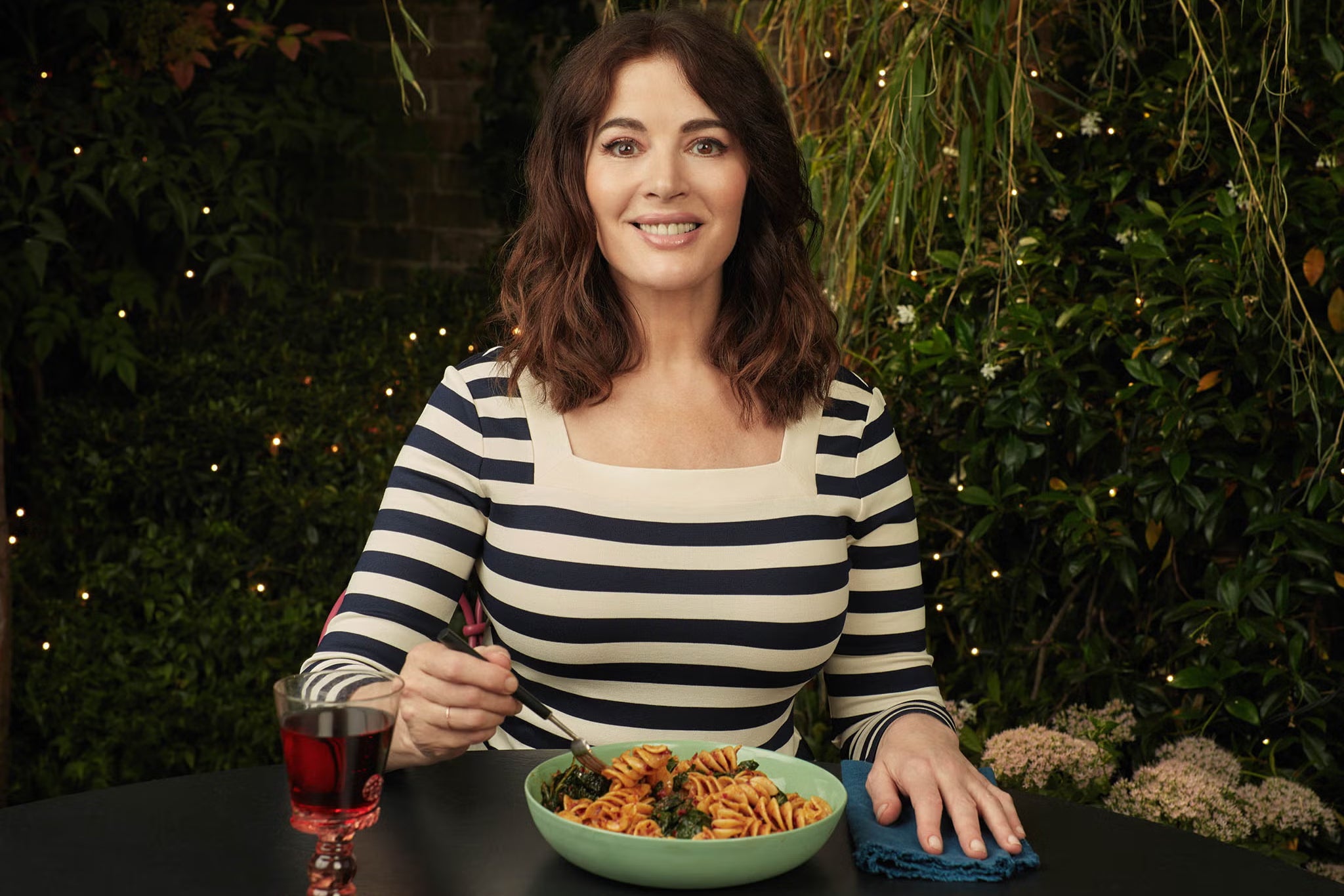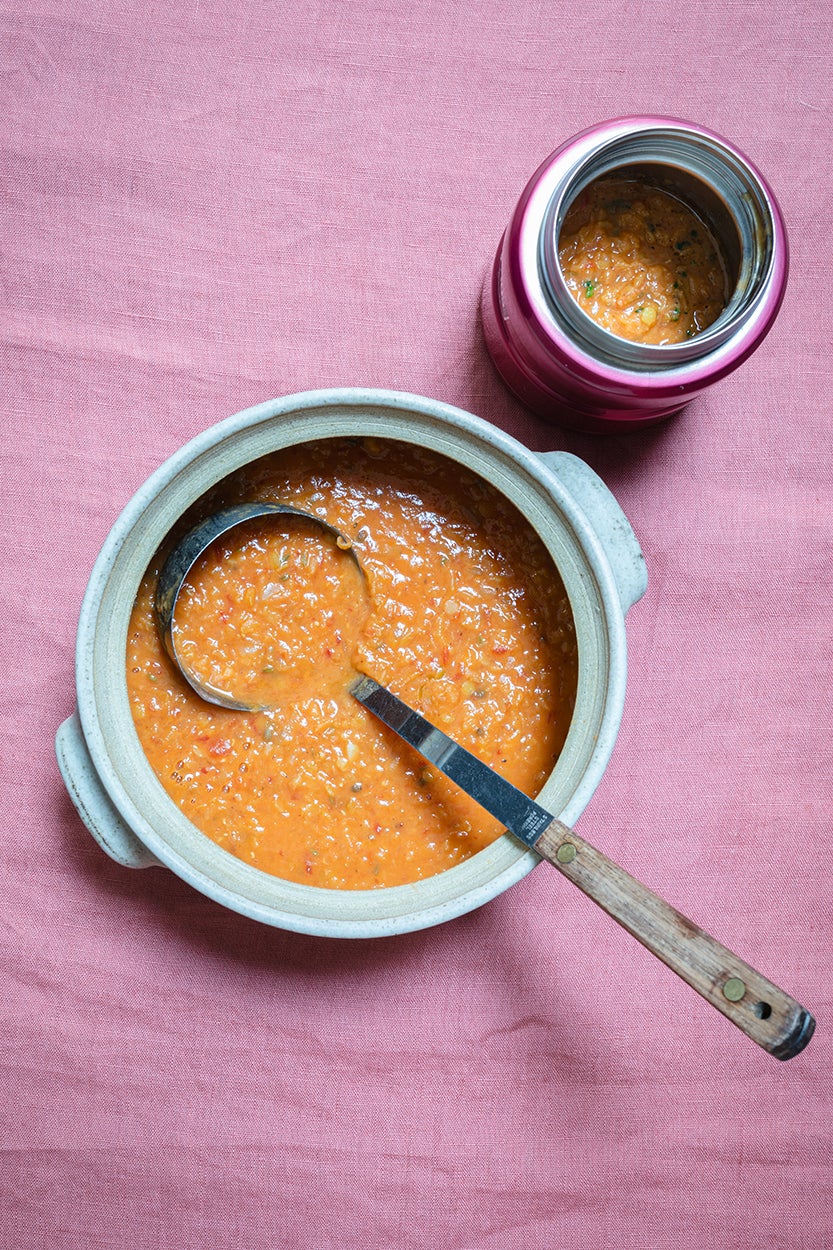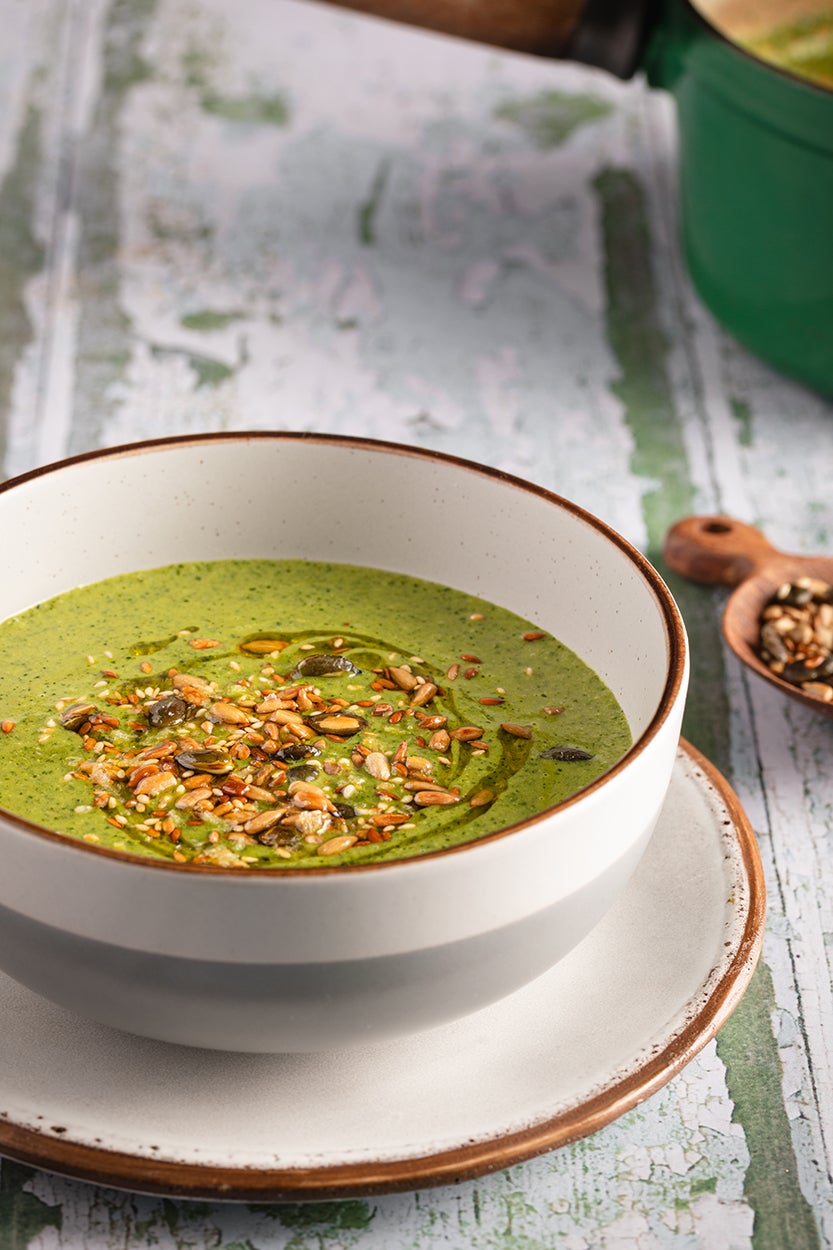The Independent's journalism is supported by our readers. When you purchase through links on our site, we may earn commission.
Soup season with a twist: How everyone – from Nigella to Ed Balls – is cooking for good
In an old laundromat near King’s Cross, there is a food bank and community kitchen that is doing more than filling stomachs. Hannah Twiggs visits Cook For Good, an amazing initiative giving dignity back to locals who may be struggling, and checks out their new soup cookbook serving up delicious recipes from everyone from Nigella and Ed Balls


It’s a Thursday morning on the Priory Green estate, just a stone’s throw from King’s Cross, and the air is thick with the smell of Italian bread soup – slowly simmered tomato broth and garlicky meatballs. There’s a queue forming – not outside some artisanal cafe, but at the door of a food bank. Except this isn’t your typical food bank. This is Cook For Good – a lifeline for many, a revolution for the rest.
For £3.50 – roughly the price of a single fancy coffee in most London postcodes – locals can come in, grab 10 items from the Pantry (an Aladdin’s cave of donated surplus food) worth between £30 and £35, and sit down for a free coffee, pastry and a chat. You’d think a space this vital would be bustling with the frantic, transactional energy of need. Instead, it’s calm, purposeful and somehow full of warmth.
“We lay it out much more like a shop,” says Karen Mattison, one of the co-founders. “It means the people coming don’t carry the stigma that can be associated with a food bank. They’ve got choice, they’ve got dignity.” Two words you rarely hear in the same sentence as “food bank”, but at Cook For Good, it’s gospel.
There are no conveyor-belt demeaning handouts here that make people feel like they should be grateful for whatever they can get. This is something else entirely. It’s radical, humane and, quite frankly, joyous.

Mattison, who has made a career out of social enterprises, had one last idea brewing when she turned 50. “I’ve always been a big believer that food can bring people together,” she explains, and this place is living proof of that.
The concept, launched during the pandemic when food insecurity hit hard, took an empty laundry building and turned it into the heart of the estate. “On every housing estate there are loads of disused spaces that could be brought back to community use,” she says. “What we noticed was people really wanted to stay. They didn’t want to leave,” Mattison says. And so, the cafe was born – a space to sit down, chat and gossip over a cinnamon bun or two. It’s the little things that make this place mighty.
Martha, the community manager, knows all about the little things that make a big difference. “I’ve met people at the door who are really nervous to come in at first,” she tells me. When I arrived, she was greeting each member by name and asking how they were. “But then they come back again and again and they love it. They’re proud of it.”
Martha is the real deal. She grew up on the estate and knows these people, their lives, their struggles. When Mattison first interviewed her for the job, she asked what Martha wanted the Pantry to feel like. Martha didn’t miss a beat. “I’d like it to feel like people are walking into Waitrose.”
During one of the first focus groups they held, a member of the community turned to Martha and said exactly that. She still gets emotional about it. “Honestly, I cried my heart out that day.”

Martha knows firsthand what it’s like to be on the other side of the counter. “I have been at that end,” she says. “I’m not ashamed of it. I had young kids; I needed that help.” And now, she’s paying it forward. She’s proud of what this place has become. “When we first came here, people didn’t believe we could do it,” she recalls. “They thought we were just another bunch of do-gooders and that we’d leave because we couldn’t make it work. And now I say to them, ‘What would you have done if we left?’ And they’re like, ‘Don’t even say that.’”
All of the volunteers at Cook For Good are from the local community, and it does much more than operate as a food bank – it also provides training courses to help them get back into work. “They get their food hygiene stipulation, they get front of house, back of house, basic knife skills,” explains Mattison. “And if they’re not ready to get a full-time job, we give them professional work as casual workers on our team.” Martha handles the recruitment, and it’s a responsibility she relishes. “I get the best job because I get to tell people they’ve got through – they scream with joy.”
Cook For Good’s breakout star, though, is the soup. It all started when Mattison brought a flask in for her lunch one day and shared it with one of the volunteers, “Mary, who’s an older woman. She hadn’t really been out for about 10 years. She lost her son, and started coming in as a volunteer. She said, ‘Oh I don’t really cook’, so I gave her a taste. She was like, ‘How do you make that?’”
Mattison started bringing in soup every week, and now they serve soup every Thursday from 10.30am and people queue up for it. There’s always two on offer, with recipe cards members can take home and try for themselves.
This love affair with soup has since grown into something bigger: Soup For Good, their new self-published cookbook. It’s filled with recipes contributed by the community – from traditional family recipes passed down through generations to dishes that make the most of the ingredients you might find in the Pantry.

Alongside these recipes are stories from the people who make this community what it is: a living testament to the power of food. And it’s not just locals who’ve filled its pages; recipes from everyone from Nigella Lawson to Stanley Tucci make appearances, too. The production of the book was sponsored, so all of the proceeds go back into the project.
But running a project like Cook For Good is no walk in the park. “Most food banks are on their knees,” Mattison says. So how do they keep it going? Just around the corner is their kitchen, occupying a former cafe, another disused space, where corporate groups from the likes of Google and Deloitte come in for a team-building day. The catch? They spend the day cooking meals for the shop. “They cook around 100 meals and those meals either get sold in the pantry or donated to local charities,” Mattison explains. The corporations pay for the experience, and that money keeps Cook For Good afloat.

The kitchen also runs free cooking classes for locals, covering everything from cooking for diabetes to meals for young children. Once a month, they host a community dinner, where professional chefs come in to cook members a three-course meal, replete with waiters and menus. “People here don’t tend to go to restaurants,” says Robinne Collie, Mattison’s co-founder and head of the kitchen. So, they bring restaurants to them, serving up a variety of cuisines. “Tomorrow, it’s west Indian,” says Collie.
For some, the kitchen has become much more than a place to get a hot meal. Shylah came through the training programme and now works in the kitchen. She started in the KP (kitchen porter) room, washing dishes, but quickly excelled and has just completed her first corporate event.
For Shylah, the kitchen offers more than just a job. “It feels like a home away from home,” she says. “It builds our confidence and especially combats isolation.” For her, the kitchen also provides a peaceful escape. “I’ve got six children always talking,” she laughs, “and this is the one place I can go and not speak.”
For older men on the estate, Mattison noticed that they came to shop but never stayed to chat. So, they started the Grub Club, a cooking class just for men. “Once we started the Grub Club, they started coming,” she says. “It’s joyful. We have men who now volunteer, who were once [[too] shy to stay. It’s very special.” Alec, a retired gentleman and one of the Grub Club regulars, nods with pride. “This is the only place in the whole of London where you can guarantee that there’s going to be an event for men,” he says.
The point is, by focusing on dignity, choice and sustainability, Cook for Good is doing far more than feeding people – they’re building a community. They’re offering hope in a city that too often leaves people behind. And that ripple effect is what makes this place so special. The volunteers, many of whom were once Pantry users, now give back to the community that once supported them.
As the lunchtime soup queue forms again, Mattison looks around, her pride evident. “It’s always about the soup,” she says with a knowing smile.
The Pantry’s original tomato and red lentil soup

“Here’s where it all started, with this simplest of recipes, which Karen brought along to the Pantry for her lunch one cold winter’s day. Volunteer Mary asked what was in her flask, Karen offered her a taste… and it all took off from there. Within a week, our staff were bringing in enough to share with the volunteers; within a month, we were serving members two soups every Thursday. Two years later, here we are, with a book full of recipes and a shared love of soup.”
Serves: 4-6
Prep time: 10 minutes | Cooking time: 40 minutes
Ingredients:
1 onion
2 garlic cloves
2 tsp coriander seeds
2 tsp cumin seeds
2 tbsp olive oil or butter
250g red lentils
2 × 400g tins chopped tomatoes
1 litre vegetable stock
Salt and pepper
Method:
Peel and finely chop the onion and garlic. Crush the coriander and cumin seeds in a pestle and mortar.
Set a large saucepan or shallow casserole pan on a medium heat. Add the olive oil or butter along with the diced onion and garlic. Add a pinch of salt, lower the heat, and gently cook until soft but not coloured.
Add the cumin and coriander and toast for a minute or until fragrant. Stir in the lentils and stock. Bring to the boil, then lower the heat, and simmer for 15 minutes.
Stir in the tomatoes and a pinch of salt and pepper. Bring back up to boil, then lower the heat, and simmer for another 15 minutes, or until the lentils are tender. At this point, the soup is ready. You can serve as it is or, for a smoother consistency, blend or partially blend it.
Ed Ball’s prawn pho

“Former politician Ed is a seasoned foodie and winner of Celebrity Best Home Cook, who has supported us since our earliest days. He hosted the first-ever Cook for Good Supper Club in September 2022, working with our volunteers to cook a three-course meal and demonstrating his signature soufflé for our guests. He fell in love with Vietnamese cooking when he was on Strictly, and while he doesn’t always find it easy to get the same light spicy and salty tastes at home, this one really works: ‘A healthy, fiery soup with a wonderful aroma and deep flavours.’”
Serves: 4-6
Prep time: 25 minutes | Cooking time: 35 minutes
Ingredients:
3 garlic cloves
3 lemongrass stalks
3 red bird’s eye chillies
A small thumb of ginger (approx 5 cm)
A handful fresh coriander leaves
A handful of mint leaves
1 litre chicken or vegetable stock
100g beansprouts
100g vermicelli rice noodles
400g peeled tiger prawns
4 tbsp fish sauce
3 limes, quartered
Method:
Peel and thinly slice the garlic. Remove the outer layer from the lemongrass stalks, bash with a saucepan to soften, and then cut in half. Finely chop one of the chillies. Bash the ginger with a saucepan to soften. Strip the coriander and mint leaves from the stalks and discard the stalks, reserving the leaves.
Put the stock in a large, heavy-based saucepan. Add the garlic, lemongrass, whole chillies, half of the chopped chilli, and the ginger. Bring to the boil and simmer for 30 minutes. Meanwhile, put the noodles into a saucepan, cover in boiling water, and cook for 4 minutes. Turn off the heat.
Add the prawns and 3 tablespoons of the fish sauce to the stock and simmer for a further 5 minutes. Turn off the heat. Remove the lemongrass, ginger, and whole chillies. Add the beansprouts and a handful each of coriander and mint leaves. Taste for balance and adjust with more fish sauce to taste.
Drain the noodles and place in serving bowls. Ladle over the soup and sprinkle the remaining chopped chilli, mint, and coriander. Serve with the lime quarters on the side.
Green goddess soup

“An immune system booster that’s packed full of flavour. You can use any green vegetables that you have in your fridge or freezer so feel free to experiment, and if you want to make it vegan, swap the cream for dairy-free alternatives or just leave it out. We love this soup’s fresh green colour and the fact that it does you good as well as tasting good. We serve it regularly when we get to cough and cold season.”
Serves: 6
Prep time: 15 minutes | Cooking time: 30 minutes
Ingredients:
1 onion
4 garlic cloves
1 leek (white part only)
1 medium fennel bulb
3 celery sticks
1 potato
1 head broccoli
150g kale
2 tbsp olive oil, plus extra for drizzling
¾ tsp ground allspice
¾ tsp ground cumin or coriander
1.25 litres water or vegetable stock
200g frozen or fresh peas
200g spinach leaves
180ml double cream
Salt and pepper
Method:
Peel and finely chop the onion and garlic. Wash the leek and thinly slice. Cut the fennel and celery into 1 cm dice. Peel and cut the potato into 2 cm cubes. Cut any hard parts away from the broccoli stalk and then cut the florets and stalk into 2 cm pieces.
Strip the leaves from the kale. Roughly chop the leaves and finely chop the stalks (discard any really woody stalks).

Set a large saucepan or shallow casserole pan on a medium heat. Add the oil followed by the onion, garlic, leek, fennel, and celery. Cook for 5–10 minutes until softened. Add in the spices and cook for another minute or until aromatic. Add the water or stock, potato, broccoli, and kale. Season with salt and pepper.
Stir, bring to a gentle simmer, and cook for 10–12 minutes or until the potato is tender.
Take the pan off the heat and add the peas and spinach. Blend until as smooth as possible. Stir in the cream right before serving.
Top it off: Amplify the goodness of this delicious green soup by finishing it off with toasted seeds and a drizzle of olive oil.
No stress bread: Our wholegrain seeded loaf, sliced and lightly buttered, is the perfect partner for this nourishing soup.
Soup for Good: Recipes and Stories from the Cook for Good Community is available now





Join our commenting forum
Join thought-provoking conversations, follow other Independent readers and see their replies
Comments